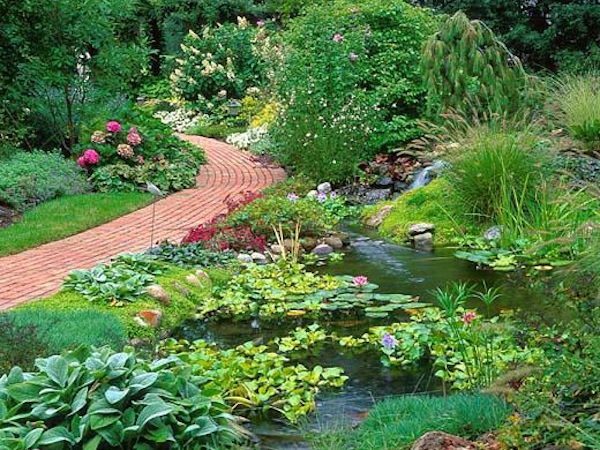
One of the home improvement projects a homeowner rarely has to be sold on is improving their backyard. Most homeowners realize that with the right landscaping and patio their backyard can be an additional living space. In fact, during summer evenings and spring and fall afternoons, your backyard may very well be preferable to spending your leisure time cooped up inside your home. One of the most common mistakes homeowners make when looking into improving their backyard is to convince themselves certain installations are out of their price range without even getting quotes. Small and moderately designed garden ponds and waterfalls, for example, are rarely as expensive as many homeowners imagine.
Garden Pond Liners
The biggest decision you’ll most likely need to make is what material your pond liner will be. More permanent garden pond liners include concrete and fiberglass. More flexible pond liners are generally made from a variety of different plastic products. Permanent garden ponds aren’t strictly permanent, but if they’re well-built, a fiberglass liner should last 50 years or more, while concrete may last even longer in the absence of extreme freeze/thaw cycles. Concrete has the slight disadvantage of possibly leaking toxins that can affect the quality of your pond water. Fiberglass is much easier to install and maintain but lacks the naturalistic quality of other pond liners.
Plastic pond liners can actually be rigid or flexible, but rigid plastic liners are difficult to work with and are susceptible to damage from ice and other weathering elements. Rigid plastic liners usually work best for homeowners who live in a warm climate and are operating on a strict budget. Flexible pond liners can be any number of materials such as butyl rubber and PVC, among others. These different pond liners may vary slightly in cost and performance, but they generally last 10-20 years, and their flexibility makes them great for customized garden ponds.
Garden Pond Design and Installation
Along with choosing a pond liner, you’ll also need to start thinking about your pond design. Obviously shape, size, and location are the big elements of pond design. Depending on what plants and/or fish you plan on putting in your pond, you’ll probably want to look for a place that gets a decent amount of shade. Besides being conducive to a healthy pond, shade from the sun will also increase the life of most pond liners. Size and shape are usually a function of the size of your yard and the size of your budget. Creating a more organic shape may be more important than an impressively sized pond. Plus, you may want to save enough money in your budget to install stone edging or otherwise spruce up the surrounds of your garden pond.
Ready to start your garden water features?
Find ProsGarden Waterfalls
Of course, a garden waterfall is one of the best and most popular ideas for your pond surrounds. Garden waterfalls, like the ponds they typically run into, come in all shapes and sizes. The benefits of a waterfall are two-fold: the relaxing sound of running water and the beautiful look of falling water. With these two qualities in mind, you’ll want to find a design that’s right for your backyard. One common mistake is to go overboard on the size of the waterfall. You don’t want a waterfall that’s going to overpower your pond or your backyard. Installing a garden waterfall may or may not be a DIY project, depending on your relative skill and time availability, but the total cost of installing a waterfall for your pond is generally less than most homeowners imagine.
 Raising Chickens at Home
Raising Chickens at Home  Spring Garden Flower Tips and Suggestions
Spring Garden Flower Tips and Suggestions  Plan Ahead for a Better Yard
Plan Ahead for a Better Yard  Dry Well Cleaning & Maintenance Tips
Dry Well Cleaning & Maintenance Tips  Soil Engineers & Testing
Soil Engineers & Testing 

Are You Familiar With This Topic? Share Your Experience.